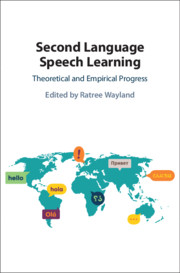Book contents
- Second Language Speech Learning
- Second Language Speech Learning
- Copyright page
- Dedication
- Contents
- Figures
- Tables
- Contributors
- Preface
- Acknowledgments
- Part I Theoretical Progress
- Part II Segmental Acquisition
- Part III Acquiring Suprasegmental Features
- Part IV Accentedness and Acoustic Features
- Chapter 13 Comparing Segmental and Prosodic Contributions to Speech Accent
- Chapter 14 Do Proficient Mandarin Speakers of English Exhibit an Interlanguage–Speech Intelligibility Benefit When Tested with Complex Sound–Meaning Mapping Tasks?
- Chapter 15 Foreign Accent in L2 Japanese
- Part V Cognitive and Psychological Variables
- Index
- References
Chapter 13 - Comparing Segmental and Prosodic Contributions to Speech Accent
from Part IV - Accentedness and Acoustic Features
Published online by Cambridge University Press: 21 January 2021
- Second Language Speech Learning
- Second Language Speech Learning
- Copyright page
- Dedication
- Contents
- Figures
- Tables
- Contributors
- Preface
- Acknowledgments
- Part I Theoretical Progress
- Part II Segmental Acquisition
- Part III Acquiring Suprasegmental Features
- Part IV Accentedness and Acoustic Features
- Chapter 13 Comparing Segmental and Prosodic Contributions to Speech Accent
- Chapter 14 Do Proficient Mandarin Speakers of English Exhibit an Interlanguage–Speech Intelligibility Benefit When Tested with Complex Sound–Meaning Mapping Tasks?
- Chapter 15 Foreign Accent in L2 Japanese
- Part V Cognitive and Psychological Variables
- Index
- References
Summary
In this study, segmental and prosodic properties of word-length stimuli were assessed together. Six talkers from 5 L1 backgrounds (American English, Hindi, Korean, Mandarin, and Spanish) were recorded reading English stop-initial trochaic words. The productions were played for 20 monolingual American English-speaking listeners rated the accentedness of each talker. For each token, the deviation from native English productions was determined for segmental (VOT, vowel quality) and three prosodic properties (ratios of duration, intensity, f0 across the two syllables). For each non-native language background, a linear mixed-effects regression model was created to predict accentedness ratings from the phonetic deviations, and the significance of each fixed effect was examined. In each model, the significant predictors included both segmental and prosodic properties. For Hindi and Spanish talkers, the single best predictor was segmental; however, for Korean and Mandarin talkers, the single best predictor was prosodic. Thus, even for short stimuli, both segmental and prosodic information must be considered in accounting for accentedness judgments. We conclude that listeners are sensitive to the different ways that foreign accent may be manifested across different non-native backgrounds.
Information
- Type
- Chapter
- Information
- Second Language Speech LearningTheoretical and Empirical Progress, pp. 337 - 349Publisher: Cambridge University PressPrint publication year: 2021
References
Accessibility standard: Unknown
Why this information is here
This section outlines the accessibility features of this content - including support for screen readers, full keyboard navigation and high-contrast display options. This may not be relevant for you.Accessibility Information
- 2
- Cited by
